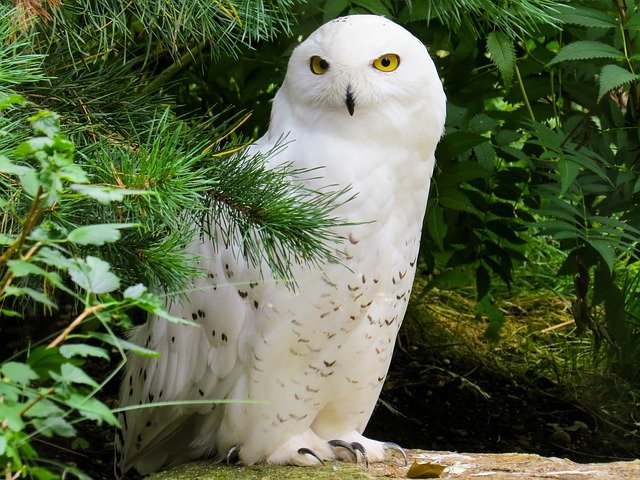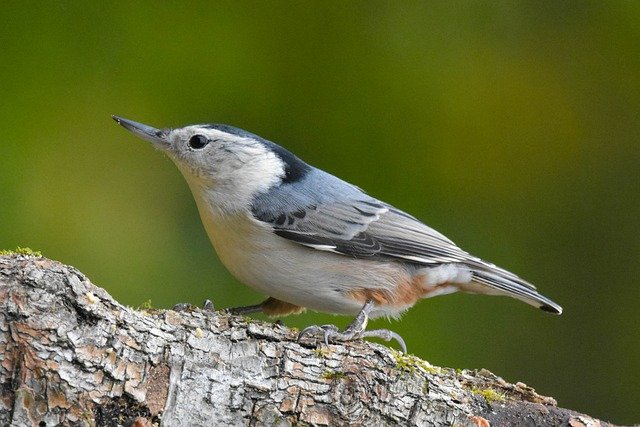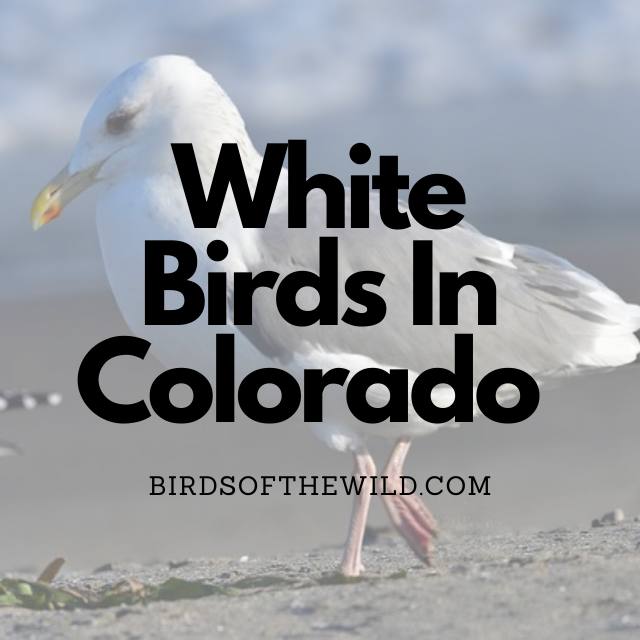Colorado has many different avian life forms suited in a variety or unique color schemes and sizes. This article in particular won’t be going over any of the more exotic colored but, as the title would suggest, I’ll be going over 5 white birds or birds with a significant amount of white on their body that consider Colorado home.
- Snowy Egret
- Snowy Owl
- White Breasted Nuthatch
- American Herring Gull
- Black Capped Chickadee
5 White Birds In Colorado
1. Snowy Egret (Egretta Thula)

- Size: 56 – 66cm
- Weight: 350 – 390 grams
- Wingspan: 95 – 105cm
You can spot snowy egrets throughout central Colorado when breeding or when they are migrating which will generally be through the eastern part of the state.
Snowy egrets as their name would suggest are snow white birds with a long neck, black beak, black legs whilst also having a relatively large frame. Besides their sexual organs the only differentiating factors between males and females are that the males are slightly larger.
You’ll find these egrets by mudflats, beaches, and wetlands, but you can also see them forage in wet agricultural fields and along the edges of rivers and lakes.
Snowy egrets eat a variety of foods from fish, insects, crustaceans which includes crabs, crayfish, frogs, snakes, snails, worms, lizards, rodents and more.
These egrets are known to live for around 5 – 6 years in the wild and upwards of 16 years in captivity.
2. Snowy Owl (Bubo Scandiacus)

- Size: 52 – 71cm
- Weight: 1.1 – 2kg
- Wingspan: 125 – 164cm
Snowy owls are non-breeding fall and winter residents within the state of Colorado.
These owls are recognised by their mostly white plumage with brown dots throughout the body. Females on the other hand are generally less white than the males as the brown spots encompass more of their body.
Snowy owls tend to spend their time within arctic tundra or open grasslands and fields, whilst avoiding forested areas.
As for what they eat, it includes lemmings and a variety of small mammals. Nevertheless, they will still occasionally eat larger mammals like like hares, rats, rabbits, etc.
Snowy owls have been observed to live for around 28 years in captivity and between 10+ years in the wild.
3. White Breasted Nuthatch (Sitta Carolinensis)

- Size: 13 – 14cm
- Weight: 18 – 30 grams
- Wingspan: 20 – 27cm
White breasted nuthatches can be found scattered across the state of Colorado on a year round basis as it’s a permanent residence of theirs.
These white breasted nuthatches are recognised by their gray back, wings and the upper head with white breast feathers. Females look the same as the males.
As for where you would find these white breasted nuthatches, it would be around mature woods and woodland edges, where they’re most commonly located by deciduous stands that have maple, hickory, basswood, oak and are even found in some coniferous forests.
They mostly consume nuts, seeds and insects, which can include hazelnuts, sunflower seeds and suet.
As for how long white breasted nuthatches live in the wild, it tends to be around 2 years with the longest lifespan recorded around 12 years.
4. American Herring Gull (Larus Smithsonianus)

- Size: 60 – 67cm
- Weight: 1 – 1.5kg
- Wingspan: 120 – 160cm
These herring gulls can be found in central and eastern Colorado throughout their non-breeding months. They will typically make their migratory passage through the remainder of the state.
American herring gulls are recognised by their gray wings, black tail feather, white feathers in the remainder of their body, yellow beak and reddish/orange legs. The females are typically a dirty light brown/gray color where it appears as if they’ve had mud sprayed across their feathers.
You’ll find these herring gulls around coasts and inland around rubbish tips, fields, large reservoirs and lakes.
In regards to what these gulls eat, it tends to be carrion, offal, seeds, fruits, young birds, eggs, small mammals, insects and fish.
American herring gulls are know to live for around 30 years on average, with the longest recorded hitting 49 years of age.
5. Black Capped Chickadee (Poecile Atricapillus)

- Size: 10 – 15cm
- Weight: 10 – 12 grams
- Wingspan: 15 – 20cm
You can spot black capped chickadee in Colorado year round.
Black capped chickadees are recognised by their mostly white plumage from breast to tail with gray wings, black throat and upper head. Females look very much the same as their male counterparts.
Your typical chickadee will spend their time within open woods and forest edge, especially where birches or alders grow. They also avoid coniferous forests.
As for what they eat, it mostly consists of insects, fruits, seeds among other berries. The diet does change based on the weather. A large portion of a chickadees diet consists of insects in the summer whilst in winter it tends to be a seed, fruit and vegetable based diet that makes up around 50% of what they eat.
Black capped chickadees are known to live for around 2 – 3 years in the wild although, the longest recorded lifespan is said to be around 11.5 years.
Amhil Khan, a dedicated nature enthusiast and the founder of BirdsOfTheWild.com, is a passionate advocate for the captivating world of avian wonders. With a deep-seated curiosity about the intricate lives of birds, Amhil’s journey began as a fascination and has evolved into a mission to inspire others to appreciate and protect these magnificent creatures.
Amhil’s love for birds led to the creation of Birds of the Wild, a platform where his expertise in ornithology, coupled with his captivating storytelling, provides readers with an immersive and educational experience. Through his lens and words, he captures the essence of birds in their natural habitats, offering a glimpse into their behaviors, migrations, and the ecosystems they inhabit.

